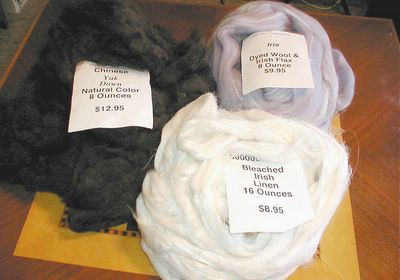
Fiber for spinning

Stamps for sorting
Which picture makes your fingers twitch to dig in?
I suspect most of you will say the first. The fiber does that to me too, at least when I was shopping, as this is a picture of my latest shopping spree at the SWIFT meeting.
But the picture of the shoeboxes of stamps is what my fingers are digging through right now, and I have been thinking lately about the reasons why. And that led to thinking about how I blog about many of my hobbies, but not stamp collecting.
On a whim last Friday I spent an hour searching to see if anyone was blogging about stamps. I found some neat blog search tools, and out of the many blogs I scanned I only found three related strictly to stamp collecting. Compare that to the hundreds of fiber blogs now being kept, often daily, it really does make one stop and wonder just what it is about this fiber, knitting, textile hobby that makes it so intensely interesting, Conversely, for me it leads me to wonder just what keeps me going back to the stamp collecting hobby since childhood.
Oh I have answers! Did you think those were rhetorical questions? Answers are what I hope come out of writing this entry.
First of all, do you have a hobby that directly reminds you of happy times with a parent? If so, then I bet you go back to that hobby at least now and then in your life. With stamp collecting, I remember my Dad, and time spent with him, learning all about how to recognize what country issued the stamp (so I still collect worldwide) learning the tiny details of how a stamp is created, learning at last how to value the stamp. There are two values to that tiny piece of paper, one, money because so few exist anymore, or two, even if it is only worth a nickel, if it is that last stamp a collector needs to fill a space in their album the value to them is priceless. Especially if they found it all on their own, while going through a big pile of stamps.
So to follow this line of thought, are many of us blogging about fiber because it reminds us of a childhood relative? I know I think of my one grandmother every time I knit. And many more relatives would have had to knit, weave, quilt, etc so there are more of us blogging about those skills.
In truth though, I know there are few stamp blogs because there is just no way to make the hobby interesting to a large number of people. It is an intensely personal hobby, sometimes shared but often persued in the quiet evening hours or a long rainy day (my Dad once told me that a neighbor said to him when it was raining, that he supposed he was having another dumb stamp day!) Even I, as much as I love stamp collecting, found the three blogs about the hobby, well, er, boring! It helped me make the decision that it really was not worth my precious internet time to start a blog about stamps, unless I could write a beginners how to....oh oh, I hate it when I have more ideas than time.
I found out some other interesting information about searching blogs, while looking for stamp blogs. It seems it is still very difficult to search the internal information of blogs. What is being searched is the title of your blog. I read several articles encouraging bloggers to make many blogs of specific information and then label your blog with key words pertinent to that topic. And those that carve and create the internet are working hard to find ways to search the internal content. At least I hit it right when naming this blog, it really is mostly about my spinning (and I am sure the reader doubts it at this point, but I promise this is the last of the stamp blogging here). I like having the link function on my sidebar that shows where this blog was discovered. Mostly of course it is from the rings, but now and then I see hits from Google.
The picture of the boxes of stamps are what I have to go through, left over from cleaning out my Dad's accumulation. Over the last three weeks, I have done nine boxes already. Hey, each box weighs from 1-2 lbs, even spinners can relate to the feel of victory over 9-18 lbs of anything! What does that mean, going through the nine boxes? It a thrill of the hunt. I could blog about the elation of finding a PNC #2 single of a bread wagon issue. Huh? It's just a different language. If I said I spun a 2 ply 21 WPI yarn on a 17:1 ratio, you'd know exactly what I mean.
The difference is in the fact that the yarn will have a future use, the stamp is just plain treasure. And we all know one man's treasure is another man's trash. That is why I and many others wade through piles of common everyday stamps. We are looking for the one that will make us go WOO HOO. The stamp I mentioned above is not worth much. It would catalog for .65 and I could probably sell it for a quarter. Why was it a find? Because I had it's siblings, plate numbers 1-3 and now I have added to that collection. Would anyone else find that interesting? Probably not.
In the end, it is probably just the old childhood language coming back to life in me: finders-keepers!
CW
